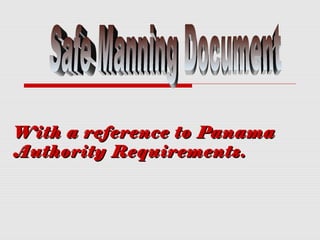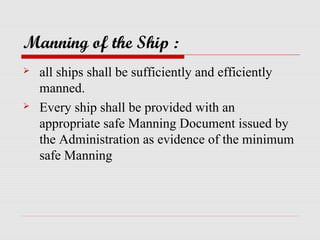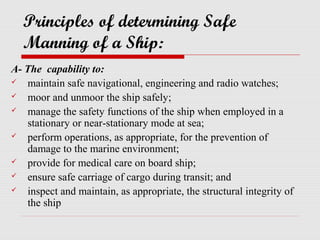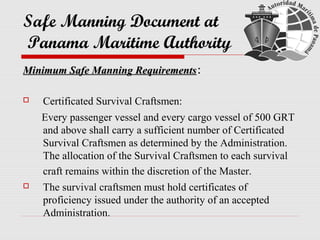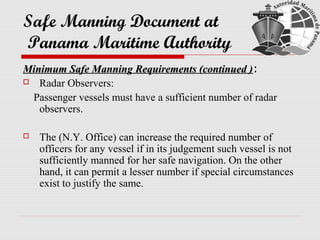Safe manning
- 1. With a reference to Panama Authority Requirements.
- 2. Manning of the Ship : ï all ships shall be sufficiently and efficiently manned. ï Every ship shall be provided with an appropriate safe Manning Document issued by the Administration as evidence of the minimum safe Manning
- 3. Principles of determining Safe Manning of a Ship: A- The capability to: ïž maintain safe navigational, engineering and radio watches; ïž moor and unmoor the ship safely; ïž manage the safety functions of the ship when employed in a stationary or near-stationary mode at sea; ïž perform operations, as appropriate, for the prevention of damage to the marine environment; ïž provide for medical care on board ship; ïž ensure safe carriage of cargo during transit; and ïž inspect and maintain, as appropriate, the structural integrity of the ship
- 4. Principles of determining Safe Manning of a Ship: b- The ability to: ïž operate all watertight closing arrangements and also deploy a competent damage control party. ïž operate all on-board fire-fighting and emergency equipment and life-saving appliances. ïž operate the main propulsion and auxiliary machinery and maintain them in a safe condition to enable the ship to overcome the foreseeable perils of the voyage.
- 5. Hours of work or rest ï Manning levels should be such as to ensure that the time and place available for taking rest periods are appropriate for achieving a good quality of rest. ï A record of the actual hours of work performed by the individual seafarer should be maintained on board
- 6. Hours of Work on Board Ship and Manning ( ILO Convention) The normal hours of work of an officer or rating shall not exceed: ïŊ when the vessel is at sea, twenty-four hours in any period of two consecutive days; ïŊ when the vessel is in port: o on the weekly day of rest, such time not exceeding two hours as is necessary for ordinary routine and sanitary duties; o on other days, eight hours except where a collective agreement provides for less on any day; o one hundred and twelve hours in a period of two consecutive weeks.
- 7. Safe Manning Document at Panama Maritime Authority Minimum Safe Manning Requirements: Requirements ïŊ Certificated Survival Craftsmen: Every passenger vessel and every cargo vessel of 500 GRT and above shall carry a sufficient number of Certificated Survival Craftsmen as determined by the Administration. The allocation of the Survival Craftsmen to each survival craft remains within the discretion of the Master. ïŊ The survival craftsmen must hold certificates of proficiency issued under the authority of an accepted Administration.
- 8. Safe Manning Document at Panama Maritime Authority Minimum Safe Manning Requirements (continued ): ) ïŊ Radar Observers: Passenger vessels must have a sufficient number of radar observers. ïŊ The (N.Y. Office) can increase the required number of officers for any vessel if in its judgement such vessel is not sufficiently manned for her safe navigation. On the other hand, it can permit a lesser number if special circumstances exist to justify the same.

